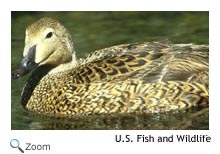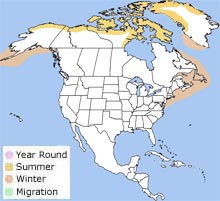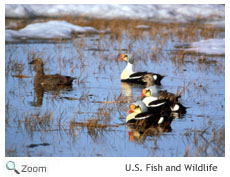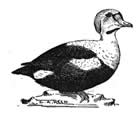Description
 The king eider is a large diving sea duck. It is
18-25
inches in length with a wingspan of 37 inches. The male has a black back, a light blue head, pale green cheeks, and a white chest and belly. He has a reddish-orange bill with an orange plate outlined in black on his forehead. The king eider is a large diving sea duck. It is
18-25
inches in length with a wingspan of 37 inches. The male has a black back, a light blue head, pale green cheeks, and a white chest and belly. He has a reddish-orange bill with an orange plate outlined in black on his forehead.
 The female is cinnamon-brown with black bars. She has a black bill and no shield on her forehead. The female king eider looks very similar to the female common eider, but she doesn't have the long, sloping forehead of the common eider. Immature males look like the female, but they have a white patch on their chest and an orange bill. The female is cinnamon-brown with black bars. She has a black bill and no shield on her forehead. The female king eider looks very similar to the female common eider, but she doesn't have the long, sloping forehead of the common eider. Immature males look like the female, but they have a white patch on their chest and an orange bill.
Range
 The king eider is circumpolar and breeds all along the Arctic Circle. In North America, it breeds along the Arctic coast of Canada and Alaska. On the east coast, it winters from
Labrador south along the Atlantic Coast. On the west coast, it winters along the coast of Alaska. The king eider is also found in Russia and Scandinavia. The king eider is circumpolar and breeds all along the Arctic Circle. In North America, it breeds along the Arctic coast of Canada and Alaska. On the east coast, it winters from
Labrador south along the Atlantic Coast. On the west coast, it winters along the coast of Alaska. The king eider is also found in Russia and Scandinavia.
|
|
|
Habitat
The king eider is found in the tundra during breeding season. In the winter, it is found in shallow coastal areas.
Diet
The king eider is a diving duck and can dive over 100 feet in search of prey. In the summer, the king eider eats
aquatic insect larvae, crustaceans, and plant matter. In the winter, it eats
mollusks, crustaceans, and echinoderms.
Life Cycle
 The female king eider lays
2-7 eggs in a
down and grass-lined depression on the tundra. The female king eider lays
2-7 eggs in a
down and grass-lined depression on the tundra.
The female incubates the eggs for
22-24
days. Once the female begins to incubate the eggs, the male leaves. The female rarely leaves the nest during incubation. The female's coloring is perfect camouflage. If she is threatened, she stretches out over the nest to try to blend in with her surroundings.
Behavior
 The down of the king eider is very soft and thick and is good insulation from cold ocean waters, but it is not collected and used in pillows and quilts like the down of the common eider because the king eider nests in remote locations that are hard to get to. The down of the king eider is very soft and thick and is good insulation from cold ocean waters, but it is not collected and used in pillows and quilts like the down of the common eider because the king eider nests in remote locations that are hard to get to.
|




 The king eider is circumpolar and breeds all along the Arctic Circle. In North America, it breeds along the Arctic coast of Canada and Alaska. On the east coast, it winters from
Labrador south along the Atlantic Coast. On the west coast, it winters along the coast of Alaska. The king eider is also found in Russia and Scandinavia.
The king eider is circumpolar and breeds all along the Arctic Circle. In North America, it breeds along the Arctic coast of Canada and Alaska. On the east coast, it winters from
Labrador south along the Atlantic Coast. On the west coast, it winters along the coast of Alaska. The king eider is also found in Russia and Scandinavia. 
